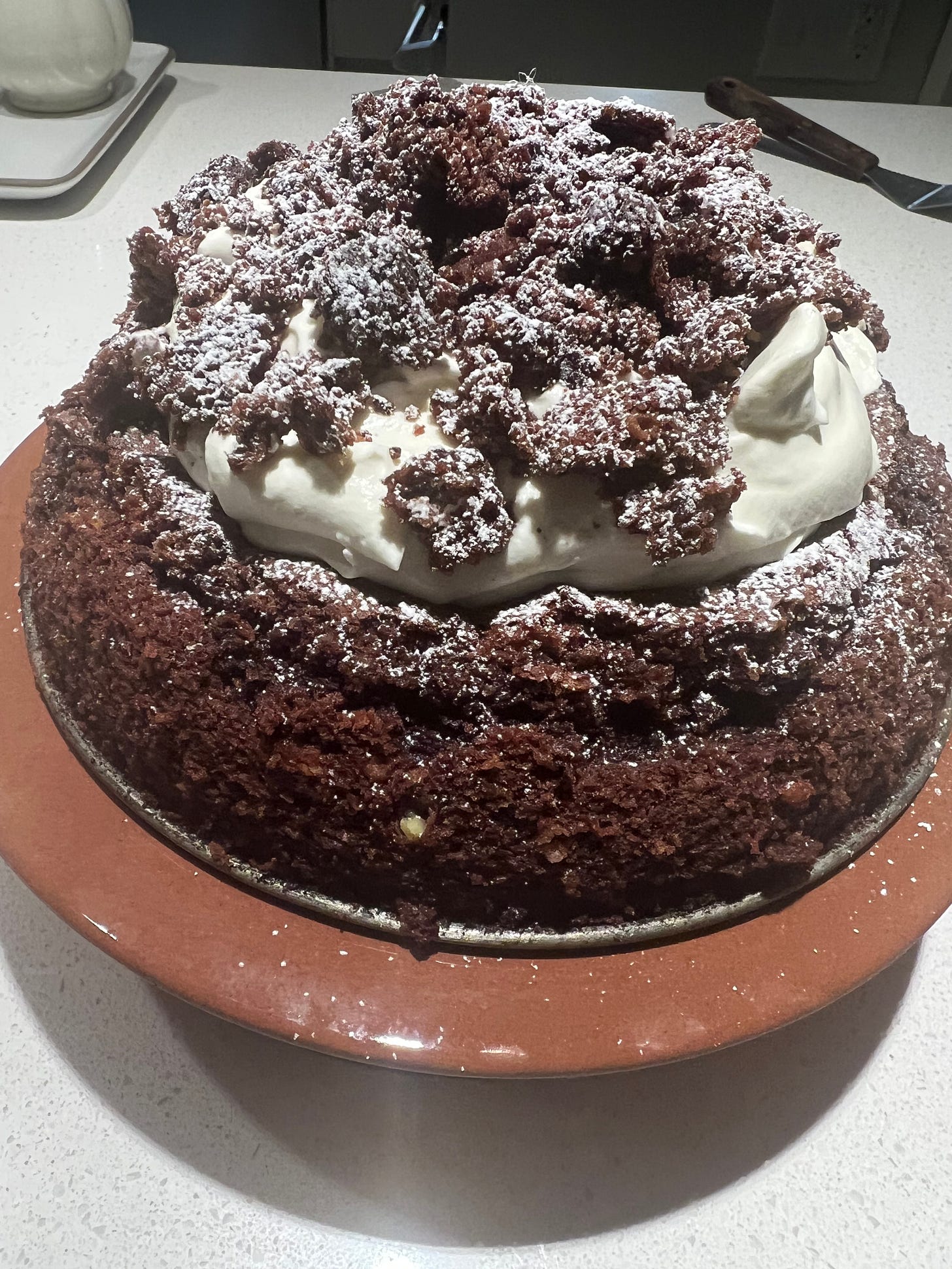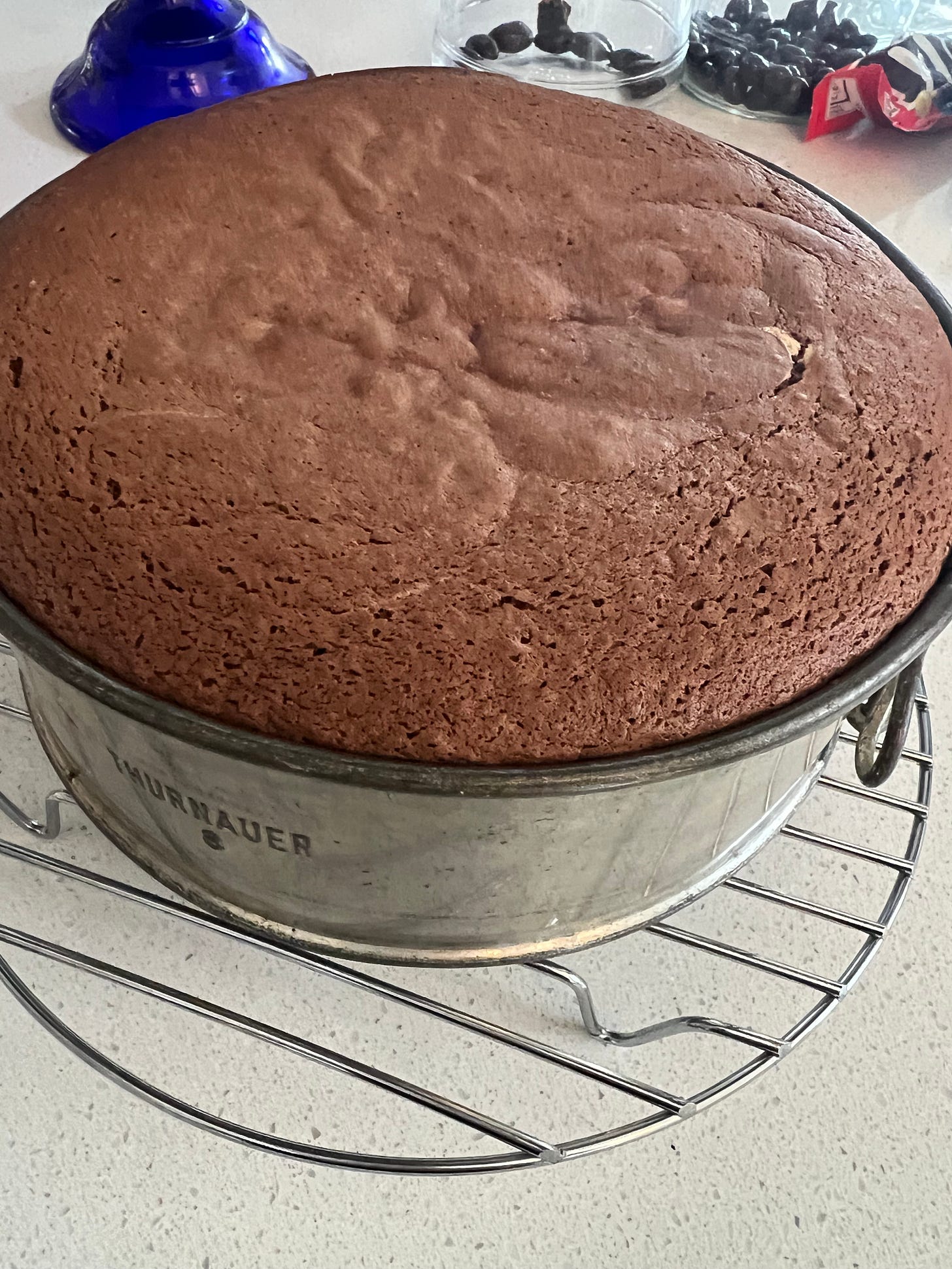Issue #122: An Elegant Chocolate Torte with Hidden Fruit
Bittman on What's Burning, Chocolate v. Vanilla, Blending Chocolate and Fruit,
Having been an opinion columnist for the New York Times for more than five years and a good food advocate for decades, it should come as no surprise that Mark Bittman does not pull any punches when discussing topics like government food policy, industrial agriculture, or even culinary education. Now he’s shopping a radical idea for a nonprofit business model of restaurants that is gaining some traction and some investment. You’ll want to listen to the newest episode of What’s Burning, just released this morning. —Mitchell
If you’ve been reading along for any length of time, you know that Nate and I disagree on the perfect dessert. My tastes tend toward vanilla, lemon, fruit, and dry. His tend toward chocolate, chocolate, moist and gooey, chocolate. And they rarely veer.
Nate will tell you, as he tells me often, that I may know something about food, but when it comes to dessert, I know nothing at all. This is not true, of course. But he doesn’t understand how anyone can not be a chocolate person. And as someone who is always looking to try new recipes and experiment with new flavors in my kitchen, gooey chocolate desserts just don’t interest me that much. You’ve made one molten chocolate cake, you’ve made them all. (If you are a chocolate lover, please don’t unsubscribe. Thanks to Nate, there’s plenty here for you, too, see cake, cookies, muffins, hot fudge sauce.)
The other day I was looking for something to make for dessert to end a dinner intended to celebrate Nate’s appointment as the new Chair of the Department of Medicine at Dartmouth Health. (Yay!) To appeal to his preferences, I was looking for something chocolate. But I also had a quart of Italian plums in the fridge I needed to use before they went bad, the last of the season (#wastenot). If the dinner were for me, I would have made my plum crumb coffee cake. Alas, this was Nate’s night.
I googled “chocolate plum desserts,” expecting to find some sort of upside-down chocolate cake with a caramelized plum topping. Or maybe a galette made with chocolate pastry. Instead, I stumbled across a recipe on epicurious.com for what seemed like a traditional, European-style chocolate torte—eggs and sugar beaten until triple in volume, small amount of flour, butter, and chocolate—only the batter included a significant amount of ripe, puréed plums.
I was intrigued.
I’m not sure I’ve ever seen a recipe for a cake before that called for anything like a whole pound of plums liquified in a blender, skin and all, to make 1 ½ cups of purée that you then fold into the batter. I had to make it.
Relatively easy and impressive, the chocolate plum torte was a hit, the fruit lightening the texture and adding a slight acidity that cut through the richness of the chocolate. Although I tend to think of chocolate desserts as wintery, this one crosses over into summer. (Admittedly, you could make it anytime of year using frozen fruit.) Everyone had a second piece.
Could I use other fruit purée, I wondered, thinking about flavors that go well with chocolate, such as raspberries or apricots? And so, I made the torte again with a purée of fresh raspberries. OMG. I’ll try apricots next, then maybe blackberries. What about cooked beets? (Don’t tell Nate.)
In the meantime, I wanted to share the recipe with you so you can enjoy it while I continue to experiment. There are still plums and late season raspberries in our local market.
A Few Notes
Like many tortes leavened, in part, by beaten egg, this one rises as it bakes and falls as it cools. Don’t worry, you’ll fill the crater with whipped cream. The only thing that should concern you is that the edges of the cake can stick to the pan, which creates a bit of a mess when the center falls. So, once the cake is out of the oven for 5 minutes, still quite hot, it’s good to run a thin knife around the top of the edge to loosen it so it collapses evenly. If you forget or pieces still fall off, just crumble them on top (see photo, below).
Also, I couldn’t find my 9-inch springform so I baked it the first time in an 8-inch one. I’ll admit there were tense moments when I thought I was going to hear the sizzle of batter splattering on the oven floor. It rose impressively high and fell dramatically low, but it was beautiful and delicious nonetheless. A 9-inch pan will produce a more stable cake. Choose your pan accordingly.
As for the fruit, so far I’ve tried the cake with purées of Italian plums and fresh raspberries. To remove the seeds, I puréed the raspberries in a food mill. As I said, I think you could use fresh apricots, preferably peeled, blackberries, and maybe even cooked beets. Frozen fruit ought to work well, too, but I’ve only done it so far with in-season fresh fruit.

RECIPE: Summer Chocolate Fruit Torte
(Makes one 8- or 9-inch cake, serving 8 to 10)
1 pound ripe plums, pitted and coarsely chopped, or 1 1/2 pints (18 ounces) fresh raspberries or blackberries, or other fruit, such as very ripe apricots, pitted and peeled
3/4 cup (1 1/2 sticks) unsalted butter, cut into chunks
6 ounces dark chocolate (around 70%), coarsely chopped
3/4 cup all-purpose flour
1 tablespoon baking powder
1/4 teaspoon kosher salt
5 large eggs, at room temperature
1 1/2 cups sugar
1 cup heavy cream, chilled
1 tablespoon icing sugar
1/2 teaspoon vanilla extract or paste
Unsweetened cocoa powder and/or icing sugar, for dusting
Preheat the oven to 350°F. With some soft butter or pan spray, generously grease the bottom and sides (all the way to the top) of an 8-inch or 9-inch springform pan and line the bottom with parchment.
If using plums or other stone fruit, place the pitted fruit in a blender and process until very smooth. If the plums are not ripe enough to form a very smooth purée, add a few tablespoons of water, whir some more, and strain through a fine-mesh sieve. If using fresh raspberries or blackberries, a food mill works best to purée the fruit and remove the seeds. You need 1 1/2 cups of purée. Reserve any additional purée to serve as an accompaniment to the torte or for another purpose.
Combine 3/4 cup butter and chocolate in a medium, heatproof bowl. Set the bowl over a medium saucepan of barely simmering water (the bowl should not be touching the water). Stir until the butter and chocolate are melted and smooth. Remove the bowl from the saucepan. Stir the fruit purée into the melted chocolate mixture until well combined. Set aside.
In a small bowl combine the flour, baking powder, and salt, and use a small whisk to blend well. Set aside.
In a large bowl, beat the eggs and the sugar with an electric mixer on high until pale and tripled in volume, 10 to 12 minutes. The mixture should be thick and when you lift the beater, you should be able to spell your name on the surface with the drip before it disappears. (This is called “the ribbon stage.”) Using a large rubber spatula, fold about 1/3 of the egg mixture into the chocolate mixture to lighten it and then fold the chocolate mixture into the remaining egg mixture until combined. Sprinkle in the flour mixture, folding to combine.
Pour the batter into the prepared pan. Bake until risen, the center is set, and the sides are beginning to brown, about 50 minutes, give or take 5 minutes on either side. Transfer to a wire rack and let the cake cool 5 minutes. Run a small, thin knife around the top of the edge against the pan, and then let the cake completely cool. The center will sink.
Meanwhile, in a clean bowl, combine the cream, icing sugar and vanilla. Beat on medium until soft peaks form. Unmold the cake (run a knife again around the edge again to help release it, if needed) and transfer to a serving plate. Mound the whipped cream in the center of the cake and dust with cocoa powder. Serve with the reserved fruit purée, if you like (unsweetened or sweetened, as you prefer).






